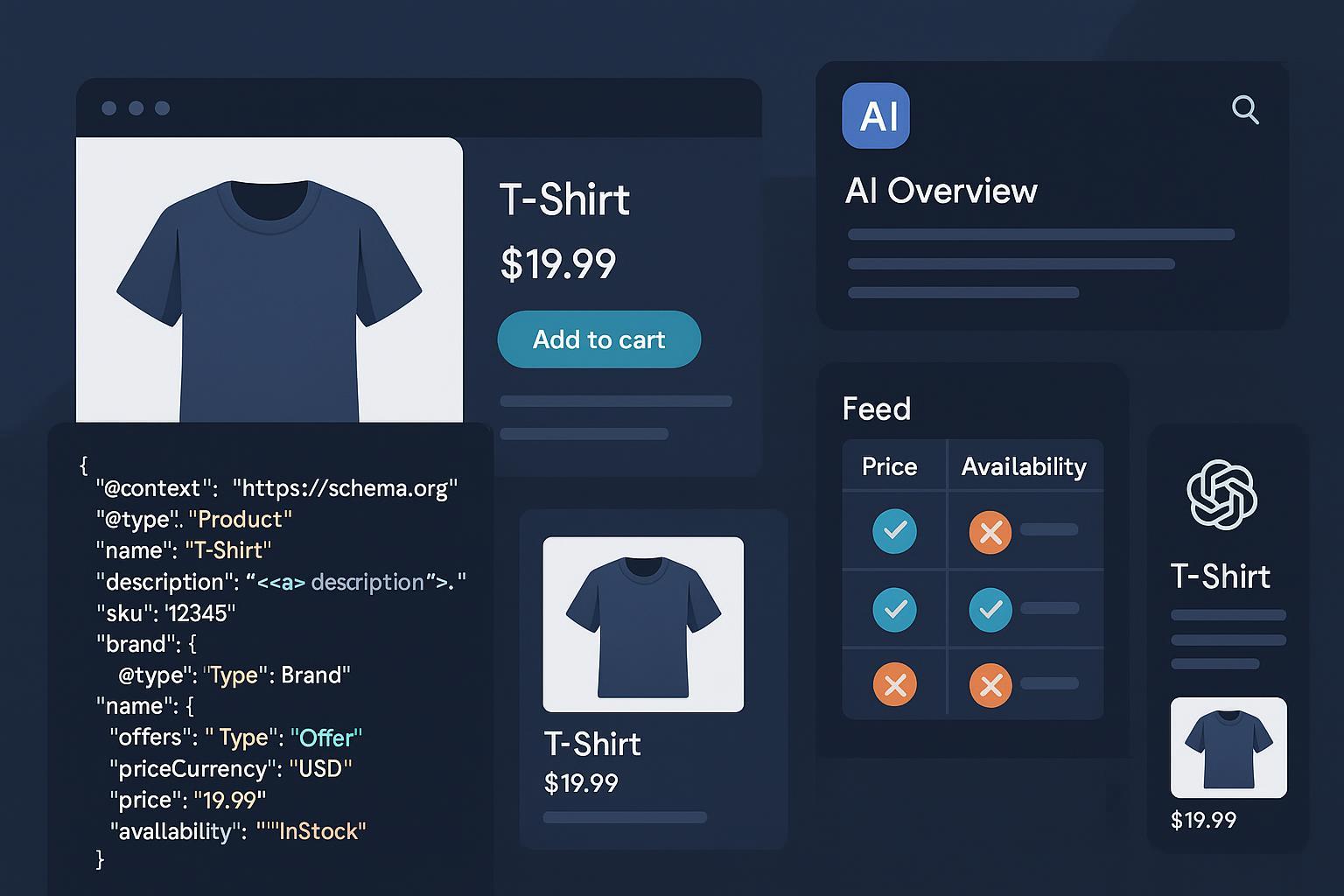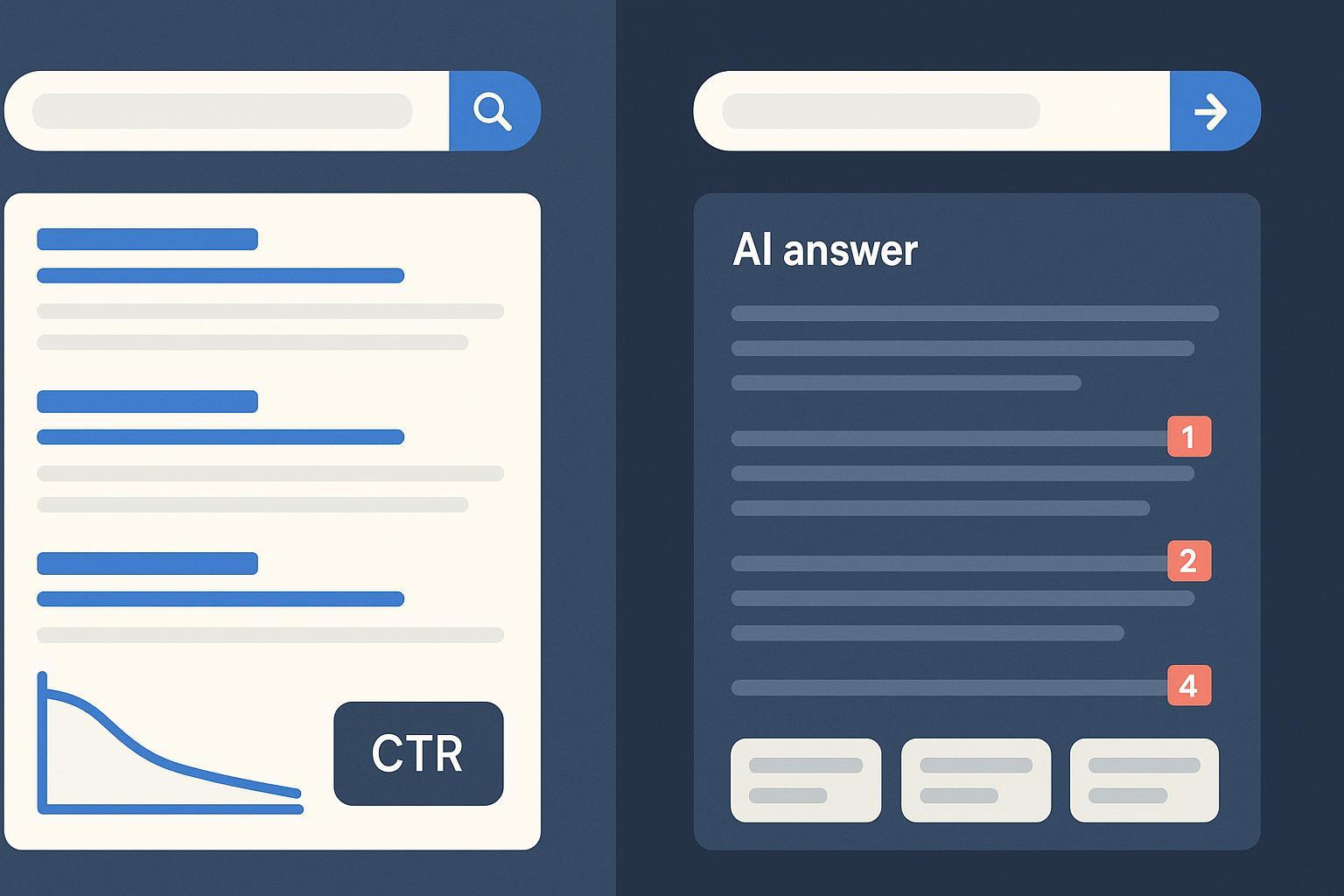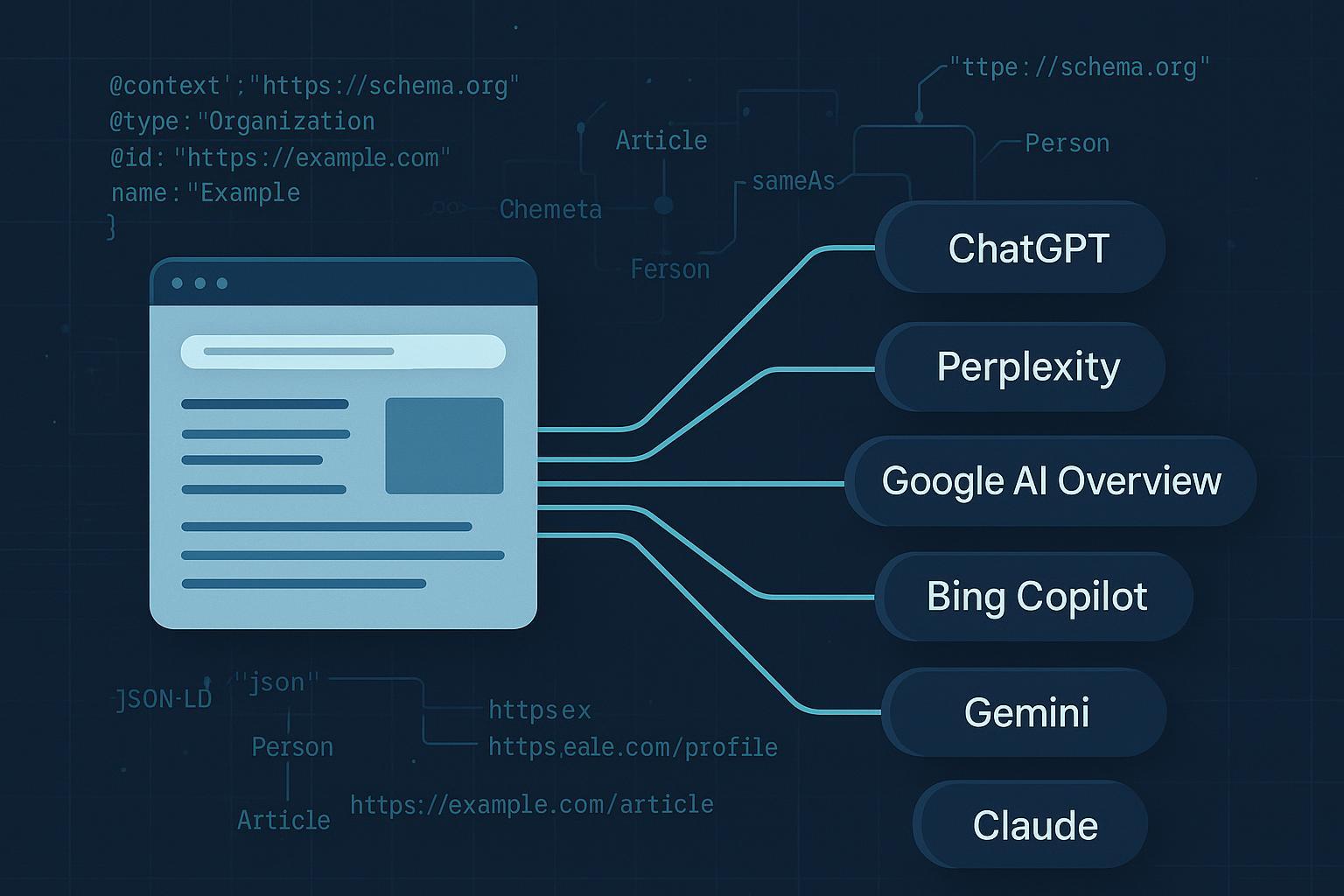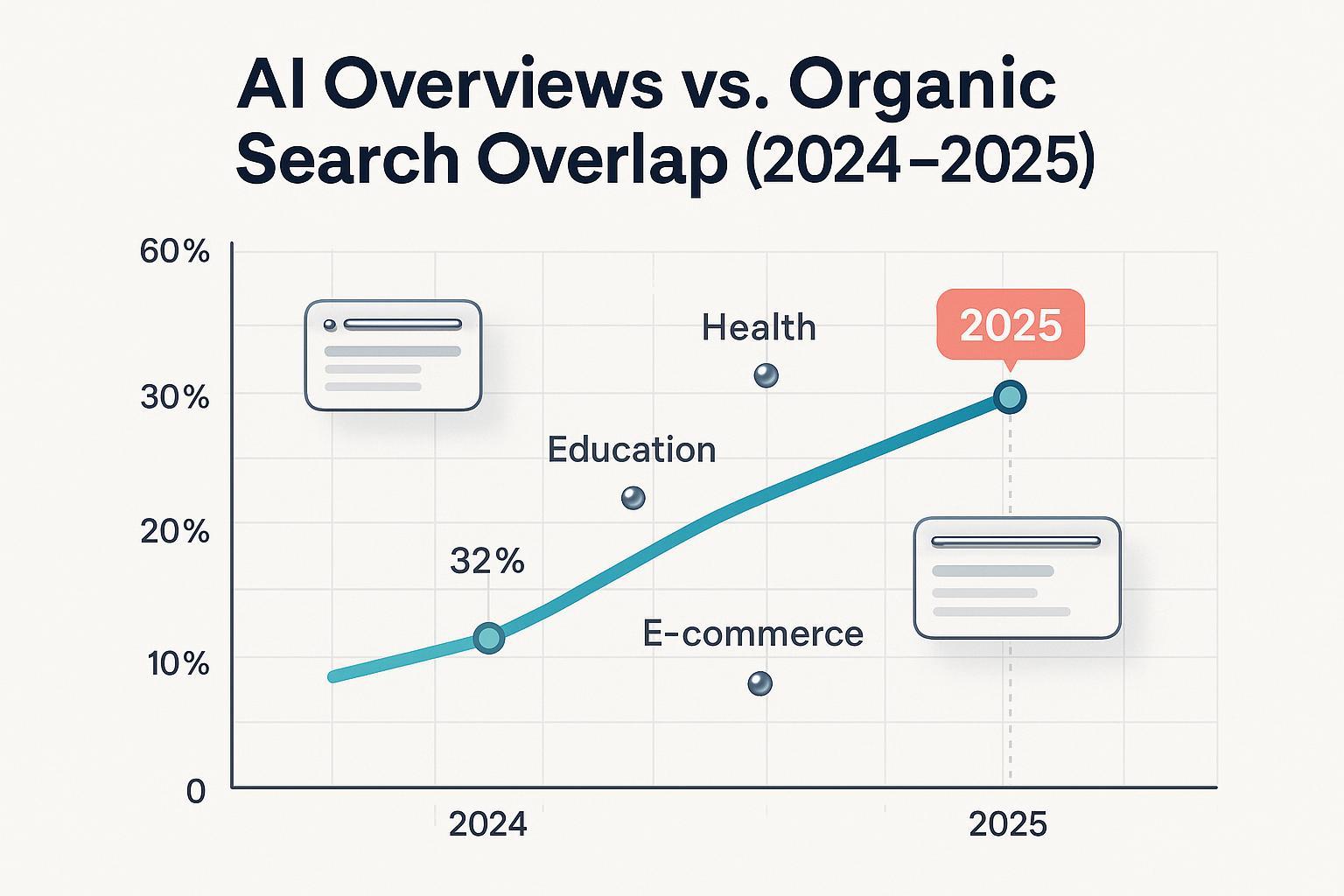Best Practices to Boost Product Content Visibility in AI Shopping (2025)
Actionable 2025 best practices for optimizing product content visibility in AI-powered shopping and search. Covers Google AI Overviews, ChatGPT, feed hygiene, structured data, and KPI tracking.


If your product pages aren’t structured and synchronized for AI surfaces, you’ll miss high-intent visibility in Google’s AI Overviews/AI Mode, ChatGPT’s shopping experiences, and Perplexity results. I’ve found the fastest gains come from aligning what’s on the page, in your structured data, and in your feeds—then reinforcing with multimodal assets and off-site trust signals. Below is the workflow I use with ecommerce teams, including platform-specific tactics, implementation details, and measurement.
1) Build AI-Parseable Product Pages
Start with pages that answer buying questions cleanly and consistently. AI systems prefer content that is specific, verifiable, and easy to parse.
- Use a clear H1 with the exact product name and model/SKU when relevant.
- Add a concise summary paragraph (2–3 sentences) stating the use case, key differentiators, and who it’s for.
- Provide a specs table. Put dimensions, materials, compatibility, warranty, and certifications in a tabular format so parsers can extract facts.
- Include a comparison table for closely related models or bundles to reduce ambiguity.
- Write scannable bullets (benefits, primary features, inclusions) above the fold.
- Publish authentic UGC: ratings, reviews, Q&A. AI systems often ground facts with review signals.
- Add a short demo video (30–90 seconds) explaining core use cases; host on a stable platform and embed cleanly.
- Create a genuine FAQ section that resolves sizing, compatibility, shipping, returns, assembly, and common troubleshooting.
2) Natural High-Intent Keywords Without Stuffing
AI shopping surfaces focus on helpfulness and precision. Map buyer intents (e.g., “best for small kitchens,” “compatible with XYZ,” “fits 13-inch laptops”) into natural sentences in the description, bullets, and FAQs. Avoid keyword stacking; prioritize clarity and context.
3) Structured Data Essentials (Parity Is Non-Negotiable)
Google outlines how to make your site eligible for AI features and rich results. Ensure your structured data matches visible content on the page.
- Follow the guidance in Google’s AI features and your website (2025, Search Central).
- Implement Product JSON-LD with offers, brand, GTIN/SKU, images, and reviews where applicable, referencing Google’s Product structured data.
- For purchase-oriented pages, add Merchant Listing structured data to expose price, availability, and merchant info.
- Use FAQPage for genuine buyer FAQs; keep answers concise and non-promotional.
Example Product JSON-LD (simplified):
{
"@context": "https://schema.org",
"@type": "Product",
"name": "Acme 13" Laptop Sleeve",
"image": [
"https://example.com/images/sleeve-front.jpg",
"https://example.com/images/sleeve-detail.jpg"
],
"description": "Slim, water-resistant laptop sleeve for 13-inch devices with accessory pocket.",
"sku": "AC-13-SLV",
"gtin13": "0123456789012",
"brand": {
"@type": "Brand",
"name": "Acme"
},
"offers": {
"@type": "Offer",
"priceCurrency": "USD",
"price": "39.99",
"availability": "https://schema.org/InStock",
"url": "https://example.com/products/13-laptop-sleeve"
},
"aggregateRating": {
"@type": "AggregateRating",
"ratingValue": "4.6",
"reviewCount": "128"
}
}
Example FAQPage JSON-LD (buyer questions):
{
"@context": "https://schema.org",
"@type": "FAQPage",
"mainEntity": [
{
"@type": "Question",
"name": "Will this sleeve fit a 13.6" MacBook Air?",
"acceptedAnswer": {
"@type": "Answer",
"text": "Yes. It fits slim 13-inch devices up to 12.3" x 8.7" (31.2 x 22.1 cm)."
}
},
{
"@type": "Question",
"name": "What is the returns policy?",
"acceptedAnswer": {
"@type": "Answer",
"text": "30-day returns; unused items in original packaging. See our Returns page for details."
}
}
]
}
Implementation notes:
- The values must reflect what users see on the page. If your price or availability changes, update both the page and schema immediately.
- Keep GTINs accurate per variant; if a product lacks a GTIN, mark it appropriately rather than inventing one.
4) Feed Hygiene: Merchant Center and Catalogs
Your feeds must mirror page content and schema. Misalignments are the top cause of disapprovals and missed eligibility.
- Adhere to the Google Merchant Center product data specification: ensure price, availability, condition, identifiers (GTIN/brand/MPN), and high-quality image URLs are complete and accurate.
- Enable Automatic Item Updates to reduce price/availability mismatches; validate with Diagnostics.
- Use feed rules to enrich titles, add variant attributes, and normalize values at scale.
- Image best practices: multiple angles, no text overlays or watermarks; minimum quality thresholds; cross-check that image URLs resolve and are crawlable.
- Maintain parity across page, schema, and feed. If one says “In stock” while another says “Out of stock,” AI surfaces will downrank or disapprove.
5) Multimodal Assets: Images and Video That AI Can Trust
High-quality visuals improve engagement and help AI systems verify claims.
- Follow Google’s image SEO guidance (Search Central, 2025) for alt text, formats (WebP/AVIF/JPEG), responsive images, and sitemaps.
- When embedding video, use clear titles/descriptions and transcripts; consider VideoObject markup if the video is central to the page.
6) Platform-Specific Tactics
Google AI Overviews and AI Mode
Google describes eligibility and grounding with links for AI features. Prioritize:
- Indexability and fast rendering; avoid JS-only content for core facts.
- Helpful, verifiable content that matches structured data and feeds.
- Clear authorship/brand info, publish/update dates, and accessible design.
For details, see Google’s AI features and your website and the Google Search product blog on AI Mode.
ChatGPT Shopping Experiences
In 2025, OpenAI expanded shopping capabilities with product cards, browsing, and streamlined purchase flows. To improve inclusion:
- Make product pages cleanly crawlable and richly detailed: specs, pricing, availability, warranty, and authentic reviews.
- Add FAQs that answer buyer questions explicitly.
- Prepare trackable landing pages with UTMs to capture referred traffic, recognizing analytics are still limited.
Feature evolution is tracked in the ChatGPT Release Notes (OpenAI, 2025).
Perplexity
Perplexity encourages publishers to provide precise, verifiable content with clear sources, dates, and schema. Strengthen:
- Author and organization info; use ClaimReview for factual claims when relevant.
- Publish/update dates on product guides and buying advice.
See the Perplexity Publishers Program (2024–2025). Note that independent reports have alleged stealth crawling practices; if blocking is necessary, use layered controls (robots + WAF/bot management), as discussed in the Cloudflare analysis (2025).
Marketplaces and Social Commerce (Influence broader AI discovery)
- Amazon: Prioritize clean titles (avoid spam), comprehensive attributes, high-quality images (≥1000 px), robust A+ content; verify any generative listing outputs for accuracy and policy compliance.
- TikTok Shop: Accurate titles/descriptions, complete attributes, multiple images, at least one authentic product video. Avoid watermarks and manipulated imagery.
- Meta Shops: Keep catalogs synchronized; use product tags in posts/Reels/Stories; consider Advantage+ Catalog Ads for discovery.
7) Measurement: What to Track in 2025
AI platforms offer limited referral analytics, so combine official dashboards with pragmatic workarounds.
- Merchant Center and Content API: monitor price competitiveness, competitive visibility, promotions, and disapproval rates; see Merchant Center performance and metrics.
- Google Search Console: track Merchant Listings and Product Snippets impressions/clicks; monitor Rich Results errors.
- AI referrals: implement consistent UTMs on likely-cited pages; review server logs for referrers (including chat.openai.com and perplexity.ai); run monthly manual audits of prominent queries and product categories.
- KPI set: visibility (impressions in rich/merchant results), engagement (CTR, time on page), conversion (assisted conversions from AI-attributed sessions), and feed health (disapproval rate, GTIN coverage).
8) Troubleshooting Playbook (Common Failures I See)
- Price or availability mismatches: synchronize feeds, page content, and schema; avoid variant confusion on the landing page; enable Automatic Item Updates.
- GTIN issues: provide correct identifiers per variant; don’t reuse GTINs across unrelated products.
- Image policy violations: remove text overlays/watermarks; ensure images resolve quickly and are accessible.
- Thin or promotional FAQs: rewrite to answer real buyer questions in plain language; keep responses factual.
- Overreliance on Product schema without UGC: gather authentic reviews; add review markup when policy-compliant.
- Title stuffing (feeds/marketplaces): prioritize clarity and compliance; test incremental keyword additions rather than dumping.
9) 30–60–90 Day Execution Plan
30 days (Quick Wins):
- Clean H1s, bullets, and specs tables for your top 50 SKUs.
- Implement Product and Merchant Listing JSON-LD on priority pages; add 5–8 genuine FAQs per product.
- Fix feed disapprovals; normalize titles and attributes with feed rules; enable Automatic Item Updates.
- Add a minimum of 3 images per product with descriptive alt text.
60 days (Depth):
- Roll out structured data to the rest of the catalog; add UGC review components and review markup.
- Create comparison tables for high-confusion categories; publish short demo videos for top sellers.
- Establish a monthly AI visibility audit: sample AI Overviews, ChatGPT, and Perplexity responses for key queries.
90 days (Scale and Measure):
- Integrate Content API reporting into dashboards; track competitiveness and promotions.
- Expand internationalization: localized metadata, measurements/units, shipping/returns policies.
- Run A/B tests on titles, bullets, and media; measure CTR and conversion changes.
10) Workflow Tools and Monitoring Resources
To keep tabs on brand mentions, citations, and sentiment across AI surfaces, I recommend using a dedicated monitor alongside your analytics stack. I’ve used Geneo to track brand exposure and citations across ChatGPT, Perplexity, and Google AI Overviews, and to log historical changes over time.
Disclosure: Geneo is our own product; mention provided for transparency.
11) Guardrails and Trade-offs
- AI surfaces evolve quickly; avoid hardcoding availability assumptions. Validate features and geographies before campaigns.
- Be transparent in product pages and avoid exaggerated claims; Perplexity and ChatGPT favor sources they can verify.
- Don’t chase every possible schema; focus on Product, Merchant Listing, Review/AggregateRating, and FAQPage with strict parity.
- Layer bot controls if you must restrict certain crawlers; robots.txt alone may not suffice.
12) What “Good” Looks Like (Checklist Recap)
- Page: clean H1, summary paragraph, bullets, specs table, comparison table, demo video, authentic reviews, buyer FAQs.
- Schema: Product + Merchant Listing with accurate offers and identifiers; FAQPage for buyer questions; review markup when compliant.
- Feed: complete attributes, GTIN coverage, synchronized price/availability, high-quality image URLs, feed rules for enrichment.
- Assets: multiple high-quality images with alt text; short, informative videos; accessible embeds.
- Measurement: Merchant Center metrics, GSC rich results, UTMs and logs for AI referrals; monthly audit cadence.
- Governance: policy-compliant titles and claims; parity across page/schema/feed; layered bot controls if needed.
By following this sequence—page structure, schema parity, feed hygiene, multimodal assets, platform-specific tactics, and disciplined measurement—you’ll make your products eligible and appealing to AI-powered shopping and search experiences. The gains are measurable, and with monthly audits and small iterative improvements, they compound quickly.




